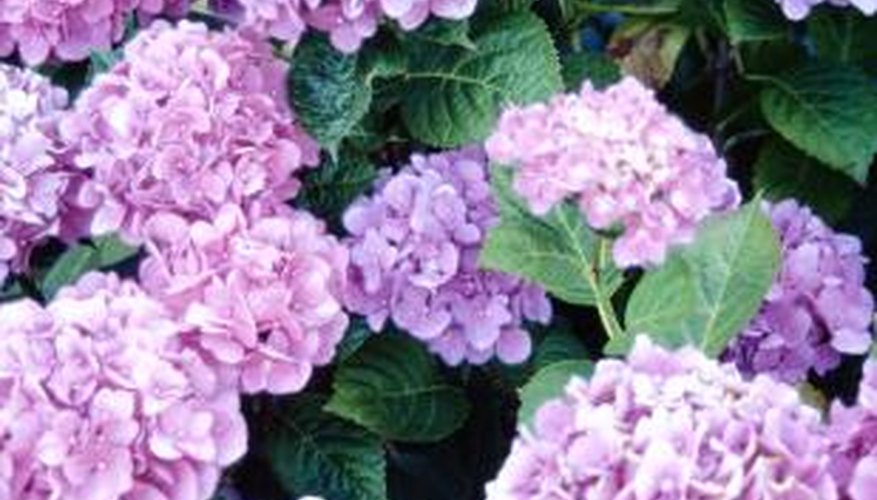Hydrangeas are low-maintenance flowering shrubs that provide colour in gardens summer through fall. The most common varieties are two forms of Hydrangea macrophylla, commonly called mopheads and lacecaps. The name "hydrangea" comes from the Greek "hydra" meaning "water," referring to the plant's great need for water -- particularly for its broad leaves -- and "angeon" meaning "vessel," referring to the shape of its seed capsule.
Monocots and Dicots
Hydrangea are angiosperms, which are flowering plants. With more than 250,000 described species of angiosperms botanists divided angiosperms into two major groups -- monocots and dicots. "Mono" means "one," and monocot means the plants, such as grasses, begin life with one leaf, or cotyledon. "Di" means "two," and dicot means the plants, including hydrangeas, begin life with two leaves or cotyledons. Monocot and dicot seeds each have a seed coat, an embryo plant and stored nutrients. Cotyledons absorb nutrients in the seed until the seedling develops its first true leaves and begins photosynthesis.
- Hydrangea are angiosperms, which are flowering plants.
- Di" means "two," and dicot means the plants, including hydrangeas, begin life with two leaves or cotyledons.
Characteristics
When mature, the leaves of monocots are long and thin, and dicot leaves are broad. Monocots' major veins are parallel and stripe-like; dicot veins branch out. Monocots have flower parts in multiples of three; dicot flower parts are produced in multiples of fours and fives. Monocot pollen has a single furrow or pore; dicot pollen has three furrows or pores. Stem vascular bundles -- fluid conducting channels -- are scattered in monocots; stem vascular bundles form a ring in dicots. Monocots' roots sprout from differing parts of the plant; dicot roots develop from the radicle, the first part of a seedling to emerge during germination. Monocots do not have secondary growth; dicots usually produce secondary growth.
- When mature, the leaves of monocots are long and thin, and dicot leaves are broad.
- Monocots' major veins are parallel and stripe-like; dicot veins branch out.
Fuzzy Distinctions
The lines between monocot and dicot classes are not always clear, according to the University of California Museum of Paleontology. Plants called paleoherbs have a mix of characteristics that do not occur together in most other flowering plants. The Nymphaeales, or water lilies, for example, have veins that branch out, like dicots, but also have what may be a single cotyledon, similar to monocots. Botanists are not able to determine whether the cotyledon is a single-lobed cotyledon or two that have fused. According to the museum, this "fuzziness" is due to the shared ancestry of the two groups.
- The lines between monocot and dicot classes are not always clear, according to the University of California Museum of Paleontology.
Angiosperms
Angiosperms make up approximately 90 per cent of the plant kingdom. They live in almost every type of land, except for the coldest areas at the poles and mountaintops. Flowering plants are also generally divided into annuals, biennials and perennials. Annuals live their entire life cycle from seed to flower to seed in one growing season. Perennials grow and flower for many years; the plant's top dies back each winter and regrows the following spring. Biennials need two years to complete their life cycle. Their growth the first year results in a small rosette of leaves near the soil surface. They produce flowers and seeds in the second year and then die.
- Angiosperms make up approximately 90 per cent of the plant kingdom.
- Annuals live their entire life cycle from seed to flower to seed in one growing season.
